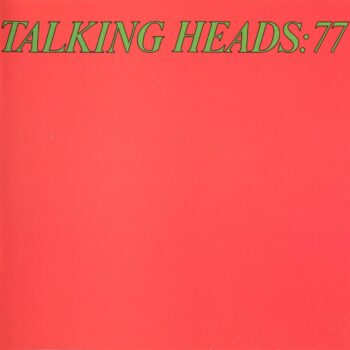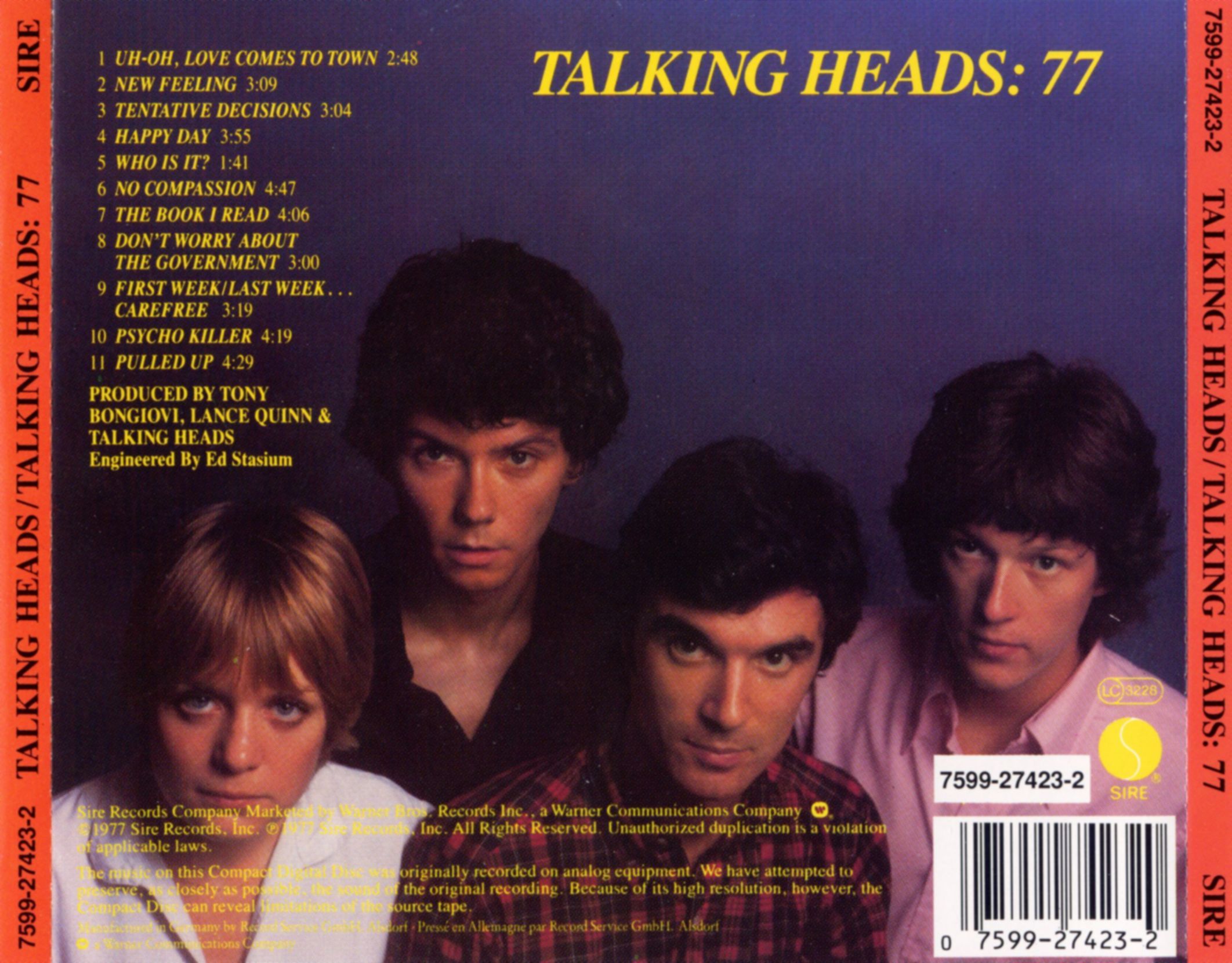
I first saw a copy of Talking Heads: 77 on the coffee table of a fellow graduate student’s apartment in Morningside Heights in 1978. (I was living in a squalid dormitory on 110 Street, so the place must have belonged to a friend of a friend in a department with more cachet than library science.) The plain red cover was meant to be noticed, as were the book by Claude Lévi-Strauss and the copy of the New York Review of Books lying beside it. In fact, Talking Heads: 77 was exactly the sort of “text” that grad student types liked to argue about. It would have been a great record even if the band members on the jacket photo hadn’t looked like my friends and me—politely pretentious Columbia students with moderately long hair and sensible shirts. But appearances count.
I had been listening to disreputable rock and roll music since the third grade. Much as I adored the music, I had always been slightly embarrassed by the culture that produced it. I wanted to convince my parents of the power and beauty of this music, and how could I when the people creating it wore leather pants and dyed their hair purple? I’m not proud of this snobbery, but there it is. Anyway, I can’t be the only reformed snob who started listening to Talking Heads for the wrong reason—that they looked like the sort of people who might subscribe to the New Yorker.
Although it was gratifying to see an image of what I wanted to look like on the back of an album cover, the group photo wouldn’t have held my attention for long if Talking Heads hadn’t been a great rock and roll band. The preppy look was significant only insofar as it implied a manner of having it both ways. Talking Heads had apparently found a way of combining art world sophistication and rock accessibility that avoided the preciousness of the former and the vulgarity of the latter. In those early days, two things, apart from the clarity and precision of their music, set them apart: one, they dispensed with the mythological, larger-than-life trappings of rock stardom; and, two, boy were they ironic.
and the vulgarity of the latter. In those early days, two things, apart from the clarity and precision of their music, set them apart: one, they dispensed with the mythological, larger-than-life trappings of rock stardom; and, two, boy were they ironic.
The four members had come from Harvard and the Rhode Island School of Design, and although it was hard to say what a graduate of RISDI was supposed to look like, somehow David Byrne seemed to exemplify the type. A band formed at an advanced art school was unlikely to take its image for granted. Although it began as real stage fright, the stiff, twitching stage presence that Byrne developed ended up subverting the strutting posturings of people like Mick Jagger, which were beginning to seem awfully tiresome in the late ’70s. Even when they became hugely successful within a couple of years, Talking Heads managed to remain anti-mythological rock stars. A little irony goes a long way.
Actually, a lot of irony. Sometimes, as in the band’s later True Stories, David Byrne laid it on a bit too thick, but on Talking Heads: 77 he used irony to suggest realities and complexities that the language of contemporary discourse and mass media could only simplify and distort. To the extent that this sort of irony implicitly recognized a human complexity maddeningly out of reach of debased forms of communication, I was all for it. To the extent that it was just smart-ass, art-school cleverness, I kinda liked it too. Whatever Byrne’s lyrics did or did not mean (or whatever they meant by abandoning the effort to achieve unitary meaning), they had a delirious, seemingly random oddness that, like a John Ashbery poem, looked easy until you tried to imitate it:
I wish I could meet everyone…
Meet them all over again
Bring them up to my room
Meet them all over againSome civil servants are just like my loved ones
They work so hard, and they try to be strongEvery sentence I use,
Refer to women and their names
Some Talking Heads songs do have a more or less determinate meaning, using naive narrators and comic indirection much the way, say, Randy Newman does. “No Compassion,” for example, advocates the opposite of its title, and in its lunatic way, “Uh-Oh, Love Comes to Town” really is a love song. Nevertheless, all these songs and others have a detachment bordering on the clinical. To my Victorian way of thinking, postmodern styles of art and discourse can’t tell us much of anything about certain primal realities of our emotional lives. Yet on Talking Heads: 77 and the next few albums the band’s approach was fresh and revelatory, and the ironic stance did not preclude all feeling. No one had yet heard a song—scary and hilarious—about a psycho killer who could slip into French and imitate Otis Redding but got mad when people repeated themselves and even madder when they weren’t polite.
Besides, it was still a rock-and-roll record. I loved Talking Heads: 77 for the same reason I loved all my other rock-and-roll records. It had scratchier guitar playing and weirder vocals and stranger tunings, but it still offered the joy and insouciance that all those other records did. Which is why it was such a thrill to see the band at their peak at an outdoor concert in Central Park in 1982. (A walk on the wild side for me; the CBGB thing was definitely not my scene.) When Tina Weymouth thumped out the three note bass line that opens “Psycho Killer,” the audience went instantly berserk. As did I. Byrne had always played on the image of being a little uptight. Well, I was a little uptight. That’s why it felt so great to be caught up in this communal ecstasy. If behind that façade of twitchy neurosis, there was an exultant soul man waiting to break out, the liberation was mine as much as Byrne’s. This was the concert in which the band unveiled to the world their new identity as the fantastically complex, polyrhythmic funk/rock/world music ensemble of Remain in Light. Suddenly (or so it seemed), Talking Heads had morphed into a sort of white James Brown Revue, but the delirium everyone felt on that hot New York night was implicit in Talking Heads: 77. The songs on that record, though far simpler, had an equally compelling mix of strangeness and sheer funkiness.
There isn’t a weak song on Talking Heads: 77. It’s funny, it’s lyrical, it rocks, and the songs stick in your head. Can we leave it at that? Well, no. Byrne, Weymouth, Jerry Harrison, and Chris Frantz were too talented, too intelligent, too well educated, and too ambitious not to want “to change the face of American music,” as Weymouth half-jokingly told Dick Clark on American Bandstand. Did they? I’m tempted to answer with the sort of evasive nonsequitur that Byrne was so good at inventing, but uh, yeah, actually, they did.




